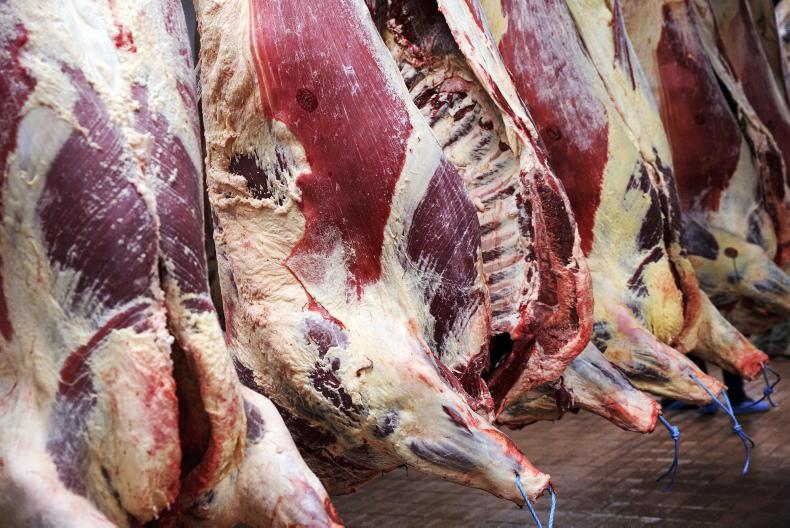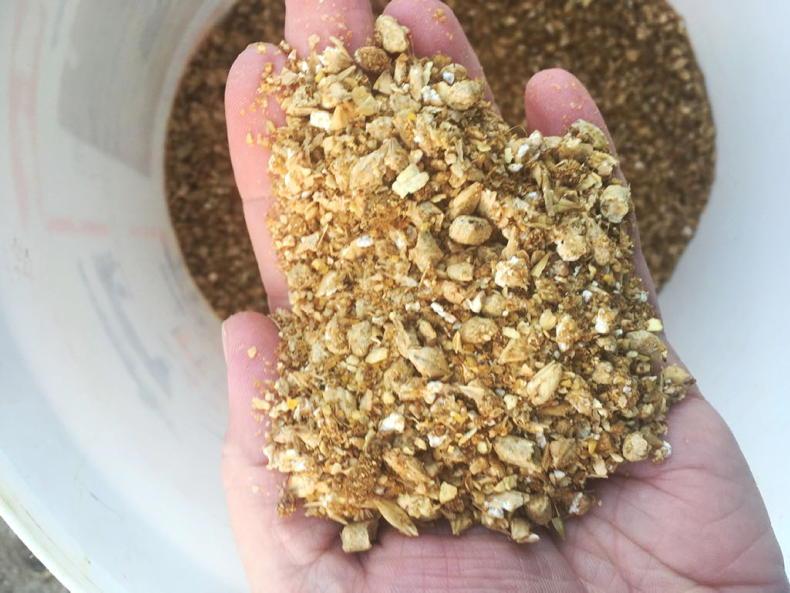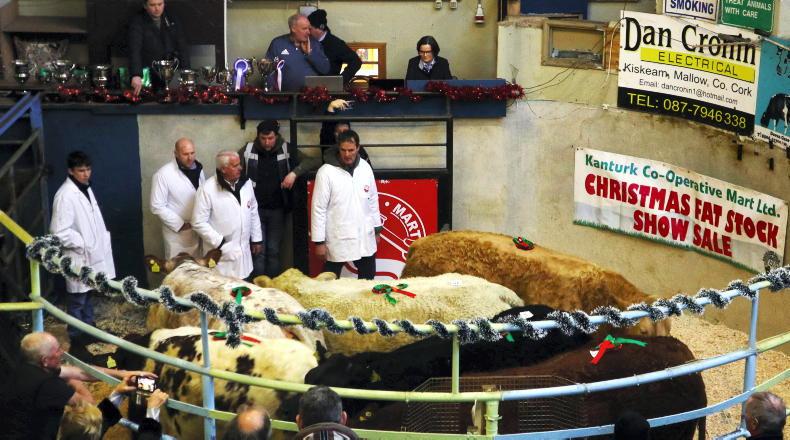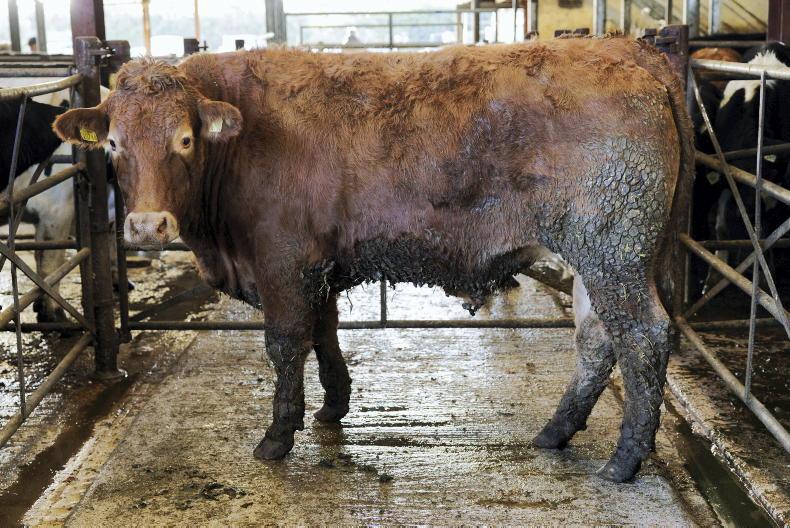Over the past six weeks, beef prices have increased significantly and there will be farmers reconsidering their winter feed and finishing plans in relation to store cattle.
However, while the rise in beef price is welcomed by farmers, feed costs are also at record highs and absorbing the increase in cattle prices.
Before moving cattle from the store to finishing phase, complete a budget to determine if higher beef prices will cover feed costs during the last 60 to 120 days on farm.
If costs are unlikely to be met, and the herd is not under movement restrictions, consideration should be given to move animals through the live ring.
Competition in the mart trade is rampant and current prices for good-quality cattle are running ahead of factory prices, although there is less of a differential on plainer animals.
If this is not an option, then consider the cost merits of putting stores back to grass and finishing in summer or early autumn, assuming there is adequate grazing ground available.
But where the plan is to push store cattle on for slaughter this spring, outlined are some tips for making the transition to the intensive finishing phase.
1 Starting weight
Before upping concentrate levels, steers and heifers should be no more than 100kg from reaching their target finishing weight. With young bulls, this figure should be no more than 180kg below the target finishing weight.
This is an important step to keep in mind. Depending on cattle type, there is a limit to how long animals can be fed on a high-concentrate diet before feed efficiency drops significantly.
Also, cattle that need to gain more weight than the outlined targets may still be in a growing phase and will therefore struggle to reach a suitable level of fat cover.
2 How long should the intensive feeding period last?
As meal levels increase, so too will the level of daily liveweight gain in cattle. But everything has a threshold and there is only so long cattle will perform to their potential on a high-concentrate diet.
In the case of heifers with native beef breeding, feed efficiency will start to drop off around 50 to 60 days on a high-concentrate diet, rising to around 80 days for continental heifers.
Continental steers can maintain high levels of performance for around 100 days when intensively fed. Steers with native breeding will be closer to 80 days.
Young bulls can maintain high levels of weight gain on an ad-lib diet for around 150 days before feed efficiency starts to tail off.
3 Ration type
With finishing cattle, energy is crucial factor to encourage animals to put on fat cover. Aim for a high maize and barley mix with energy levels at 12.5 ME or higher.
Protein is less important in finishing diets and should be kept below 14%. Any higher and this will only encourage cattle to put on lean tissue, not fat.
4 Building up concentrate levels
Concentrate levels will depend on silage quality. However, there is no place for below-average quality silage in a finishing diet.
With good-quality silage (70+ D-Value), build continental steers up to around 7kg/head, dropping back to 6kg/head for heifers.
With native beef breeds, reduce this by around 2-3kg/head. For silage of 67-69 D-Value, increase meal levels outlined by 1kg per head.
If store animals are currently on 2-3kg/day of concentrate, build up feed rates by 1kg/head every three to four days.
It is possible to limit concentrate levels to between 8kg and 10kg/day for young bulls on high-quality silage. But if forage quality is lower, then move bulls on to ad-lib feeding.
5 Splitting concentrate feeding
Once cattle are eating more than 3kg/day of concentrates, split meal feeding over a morning and night allocation. Finishing rations are high
in cereal grains which are rapidly digested in the rumen, thereby altering the
pH.
Feeding more than 3kg/head in one allocation increases the risk of acidosis, causing severe digestive upsets. Such problems can also occur if meal is offered to cattle in a fasted state.
Therefore, stick to the same feeding times every day when offering concentrates and ensure there is also fodder present.
Similarly, if cattle are on ad-lib concentrates, feed troughs should not run empty at any point. If feeders do run empty, bulls should be built back up to ad-lib levels again to avoid hungry animals gorging on fresh meal.
6 Water provision
Clean drinking water is a crucial aspect of the finishing diet, but is usually overlooked.
As meal intakes increase, cattle’s requirement for drinking water becomes much greater. As a rule of thumb, cattle will drink 5 litres of water for every 1kg of meal fed. Therefore, if water is restricted, meal intakes can drop.
Keep drinkers cleaned out and ensure there is adequate capacity in the trough to satisfy demand.
Finishing cattle should not be queuing at a water trough.
7 Feed space
When cattle are offered a set allocation of concentrates daily, all animals must be able to access the feed face at the same time.
There will be bullying when meal is fed. Dominant animals will eat more than their share, with smaller cattle receiving less, affecting weight gain.
8 Fibre
When cattle are intensively finished on concentrates, the role of forage as a fibre source is important.
If chopping straw or silage through the diet feeder, it should be no shorter than the animal’s muzzle to ensure good rumen function. Keep the fibre source fresh to improve palatability.
9 Parasite control
There is little point offering high levels of concentrates to finishing cattle that are burdened by parasites.
Make sure cattle are properly treated for lice.
Cattle with a heavy lice burden will not be gaining weight anywhere near their potential.
10 Monitor weight gain and margin over feed
Weigh cattle every 30 to 40 days during the finishing period to keep a handle on daily liveweight gain and whether there is an economic return at the upper meal feeding rate.
Steers and heifers with high genetic potential can gain anywhere from 1kg to 1.4kg/day over a 60- to 100-day period. Assuming a kill-out of 57%, this yields a daily carcase gain of 0.57kg to 0.79kg.
At a beef price of 460p/kg, these animals are generating an income of 262-363p every day during the finishing period.
On an average finishing diet of 7kg/day of concentrate (£365/t) and 25kg of silage (£20/t), daily feed costs are 306p/kg. Fixed costs, labour, finance etc have to be factored on top of this figure.
By regularly monitoring weight gain, it is easy to see when animals are not covering feed costs. As soon as these animals are adequately fleshed, they should be offloaded.
Read more
Five tips to prepare cows for spring calving
Making the most of your ICBF dairy beef weight report
Over the past six weeks, beef prices have increased significantly and there will be farmers reconsidering their winter feed and finishing plans in relation to store cattle.
However, while the rise in beef price is welcomed by farmers, feed costs are also at record highs and absorbing the increase in cattle prices.
Before moving cattle from the store to finishing phase, complete a budget to determine if higher beef prices will cover feed costs during the last 60 to 120 days on farm.
If costs are unlikely to be met, and the herd is not under movement restrictions, consideration should be given to move animals through the live ring.
Competition in the mart trade is rampant and current prices for good-quality cattle are running ahead of factory prices, although there is less of a differential on plainer animals.
If this is not an option, then consider the cost merits of putting stores back to grass and finishing in summer or early autumn, assuming there is adequate grazing ground available.
But where the plan is to push store cattle on for slaughter this spring, outlined are some tips for making the transition to the intensive finishing phase.
1 Starting weight
Before upping concentrate levels, steers and heifers should be no more than 100kg from reaching their target finishing weight. With young bulls, this figure should be no more than 180kg below the target finishing weight.
This is an important step to keep in mind. Depending on cattle type, there is a limit to how long animals can be fed on a high-concentrate diet before feed efficiency drops significantly.
Also, cattle that need to gain more weight than the outlined targets may still be in a growing phase and will therefore struggle to reach a suitable level of fat cover.
2 How long should the intensive feeding period last?
As meal levels increase, so too will the level of daily liveweight gain in cattle. But everything has a threshold and there is only so long cattle will perform to their potential on a high-concentrate diet.
In the case of heifers with native beef breeding, feed efficiency will start to drop off around 50 to 60 days on a high-concentrate diet, rising to around 80 days for continental heifers.
Continental steers can maintain high levels of performance for around 100 days when intensively fed. Steers with native breeding will be closer to 80 days.
Young bulls can maintain high levels of weight gain on an ad-lib diet for around 150 days before feed efficiency starts to tail off.
3 Ration type
With finishing cattle, energy is crucial factor to encourage animals to put on fat cover. Aim for a high maize and barley mix with energy levels at 12.5 ME or higher.
Protein is less important in finishing diets and should be kept below 14%. Any higher and this will only encourage cattle to put on lean tissue, not fat.
4 Building up concentrate levels
Concentrate levels will depend on silage quality. However, there is no place for below-average quality silage in a finishing diet.
With good-quality silage (70+ D-Value), build continental steers up to around 7kg/head, dropping back to 6kg/head for heifers.
With native beef breeds, reduce this by around 2-3kg/head. For silage of 67-69 D-Value, increase meal levels outlined by 1kg per head.
If store animals are currently on 2-3kg/day of concentrate, build up feed rates by 1kg/head every three to four days.
It is possible to limit concentrate levels to between 8kg and 10kg/day for young bulls on high-quality silage. But if forage quality is lower, then move bulls on to ad-lib feeding.
5 Splitting concentrate feeding
Once cattle are eating more than 3kg/day of concentrates, split meal feeding over a morning and night allocation. Finishing rations are high
in cereal grains which are rapidly digested in the rumen, thereby altering the
pH.
Feeding more than 3kg/head in one allocation increases the risk of acidosis, causing severe digestive upsets. Such problems can also occur if meal is offered to cattle in a fasted state.
Therefore, stick to the same feeding times every day when offering concentrates and ensure there is also fodder present.
Similarly, if cattle are on ad-lib concentrates, feed troughs should not run empty at any point. If feeders do run empty, bulls should be built back up to ad-lib levels again to avoid hungry animals gorging on fresh meal.
6 Water provision
Clean drinking water is a crucial aspect of the finishing diet, but is usually overlooked.
As meal intakes increase, cattle’s requirement for drinking water becomes much greater. As a rule of thumb, cattle will drink 5 litres of water for every 1kg of meal fed. Therefore, if water is restricted, meal intakes can drop.
Keep drinkers cleaned out and ensure there is adequate capacity in the trough to satisfy demand.
Finishing cattle should not be queuing at a water trough.
7 Feed space
When cattle are offered a set allocation of concentrates daily, all animals must be able to access the feed face at the same time.
There will be bullying when meal is fed. Dominant animals will eat more than their share, with smaller cattle receiving less, affecting weight gain.
8 Fibre
When cattle are intensively finished on concentrates, the role of forage as a fibre source is important.
If chopping straw or silage through the diet feeder, it should be no shorter than the animal’s muzzle to ensure good rumen function. Keep the fibre source fresh to improve palatability.
9 Parasite control
There is little point offering high levels of concentrates to finishing cattle that are burdened by parasites.
Make sure cattle are properly treated for lice.
Cattle with a heavy lice burden will not be gaining weight anywhere near their potential.
10 Monitor weight gain and margin over feed
Weigh cattle every 30 to 40 days during the finishing period to keep a handle on daily liveweight gain and whether there is an economic return at the upper meal feeding rate.
Steers and heifers with high genetic potential can gain anywhere from 1kg to 1.4kg/day over a 60- to 100-day period. Assuming a kill-out of 57%, this yields a daily carcase gain of 0.57kg to 0.79kg.
At a beef price of 460p/kg, these animals are generating an income of 262-363p every day during the finishing period.
On an average finishing diet of 7kg/day of concentrate (£365/t) and 25kg of silage (£20/t), daily feed costs are 306p/kg. Fixed costs, labour, finance etc have to be factored on top of this figure.
By regularly monitoring weight gain, it is easy to see when animals are not covering feed costs. As soon as these animals are adequately fleshed, they should be offloaded.
Read more
Five tips to prepare cows for spring calving
Making the most of your ICBF dairy beef weight report










SHARING OPTIONS